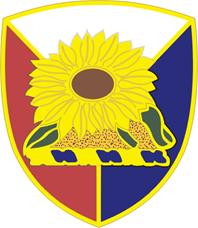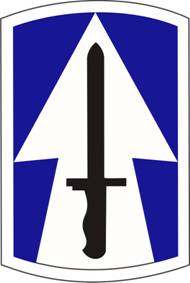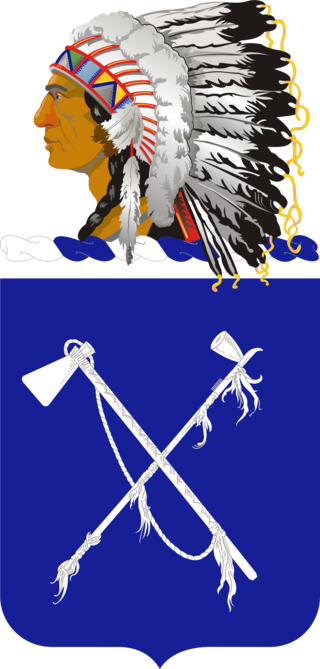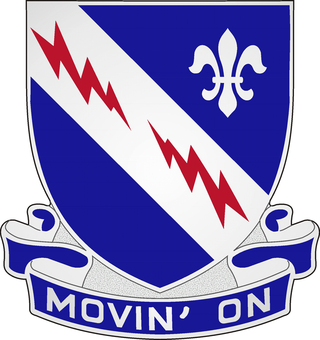
The 25th Infantry Division is a United States Army division based at Schofield Barracks in Hawaii. The division, which was activated on 1 October 1941 in Hawaii, conducts military operations primarily in the Asia-Pacific region. Its present deployment is composed of light infantry and aviation units. Tropic Lightning soldiers regularly train with other U.S. military branches to practice and maintain joint operations capabilities. The climate and terrain of the Pacific region demands Tropic Lightning soldiers be able to operate in physically demanding and harsh environments. In 2014, the division opened the Jungle Operations Training Center—the first such school in the Army since the closing of the old Jungle Warfare School at Fort Sherman, Panama Canal Zone. Joint operations and training with partner states herald a new chapter in the history of Tropic Lightning—America's Pacific Division.

The 38th Infantry Division is an infantry division of the United States Army and part of the Indiana National Guard. It is headquartered in Indianapolis, Indiana, and contains Army National Guard units from across the Midwest.

The Indiana National Guard (INNG) is a component of the United States Armed Forces, the United States National Guard and the Military Department of Indiana (MDI). It consists of the Indiana Army National Guard, the Indiana Air National Guard, and the Adjutant General's Office.

The Kansas Army National Guard is a component of the Army National Guard and the Kansas National Guard. Kansas Army National Guard units are trained and equipped as part of the United States Army. The same ranks and insignia are used and National Guardsmen are eligible to receive all United States military awards. The Kansas Guard also bestows a number of state awards for local services rendered in or to the state of Kansas. It is, along with the Kansas Air National Guard, an element of the Kansas National Guard.

The Alabama Army National Guard is a component of the United States Army and the United States National Guard. National coordination of various state National Guard units are maintained through the National Guard Bureau.

The Georgia Army National Guard is the Army National Guard component of the Georgia National Guard, administratively part of the Georgia Department of Defense. It consists of more than 11,100 citizen-soldiers training in more than 79 hometown armories and regional facilities across the state. Georgia’s Army Guard is the sixth largest in the nation and includes combat, combat support and combat service support units.
The Mississippi Army National Guard is the Army National Guard component of the Mississippi National Guard. It was originally formed in 1798. It is a component of the United States Army and the United States National Guard. It is managed by the Mississippi Military Department.

The 39th Infantry Division was an infantry formation of the Army National Guard, originally formed as the 18th Division in 1917. The division consisted of troops from Arkansas, Louisiana, and Mississippi. After training at Camp Beauregard, Louisiana, the division was deployed to France but did not see combat before the end of World War I. In July 1923 the division was re-designated as the 31st Infantry Division. The 39th Infantry Division was reactivated after World War II with troops from Louisiana and Arkansas and its headquarters in Louisiana. In 1967, the 39th Infantry Division was reorganized to become the 39th Infantry Brigade (Separate). Its headquarters was in Little Rock and the unit consisted entirely of troops from Arkansas.

The 238th Cavalry Regiment was a United States Army parent cavalry regiment, represented in the Indiana Army National Guard by Troop E, 238th Cavalry, part of the 76th Infantry Brigade Combat Team, stationed at Bluffton.

The 76th Infantry Brigade Combat Team is a modular infantry brigade of the United States Army National Guard of Indiana. It is headquartered in Lawrence Readiness Training Center, on the grounds of Fort Benjamin Harrison.

The 38th Sustainment Brigade is a sustainment brigade of the United States Army National Guard in Indiana.
The Indiana Rangers, also known as the Indiana Territorial Mounted Rangers, were a mounted militia formed in 1807 and operated in the early part of the 19th century to defend settlers in Indiana Territory from attacks by Native Americans. The rangers were present at the Battle of Tippecanoe, and served as auxiliaries to the army during the War of 1812. At the peak of their activities they numbered over 400 men.
The 150th Field Artillery Regiment is a field artillery unit in the Indiana Army National Guard.

The 179th Infantry Regiment ("Tomahawks") is an infantry regiment of the United States Army's National Guard.

The 160th Infantry Regiment is an infantry regiment of the United States Army. The 1st Battalion, 160th Infantry is a light infantry component of the 79th Infantry Brigade Combat Team (IBCT).

The history of the Arkansas Army National Guard and the Cold War involves several statewide re-organizations that occurred as a result of the evolving structure of United States Army Divisions and Brigades. In 1959 the state re-organized and restationed units in response to the Army's adoption of the Pentomic Division, the structure which was designed to counter the Soviet threat in eastern Europe. Several Arkansas National Guard units were mobilized in 1960 as part of the Berlin Crisis. In 1963 the state reorganized again as the administration of President John F. Kennedy focused on "Flexible Response" and divisions reorganized to meet the challenged of numerous small wars such as the war in Vietnam. In 1967 the 39th Infantry Division was reorganized as the 39th Infantry Brigade (Separate) as a result of a plan to reduce the total number of National Guard Divisions nationwide. The state would eventually gain a new headquarters, the State Area Command in order to provide a higher headquarters for several units which were not assigned to either the 142nd Field Artillery Brigade or the 39th Infantry Brigade (Separate).

The Kentucky Army National Guard is a component of the United States Army and the United States National Guard. Nationwide, the Army National Guard comprises approximately one half of the US Army's available combat forces and approximately one third of its support organization. National coordination of various state National Guard units are maintained through the National Guard Bureau.
Twenty-four current units of the Army National Guard perpetuate the lineages of militia units mustered into federal service during the War of 1812. Militia units from nine states that were part of the Union by the end of the War of 1812, plus the District of Columbia, are the predecessors of eighteen units that currently exist in the Army National Guard. Two of the four units derived from Virginia militias are in the West Virginia National Guard; at the time of the War of 1812, West Virginia was still part of Virginia. Only two current units, the 155th Infantry, a component of the Mississippi National Guard derived from militia units organized in the Mississippi Territory and the 130th Infantry, a component of the Illinois National Guard derived from militia units formed in the Illinois Territory, are from states or territories west of the Appalachians. Unfortunately, no militia units from the states of Kentucky, Louisiana, Ohio or Tennessee, or from the Indiana, Michigan, Missouri or Louisiana Territories, where militia units played a major role in the fighting, have survived as units in the modern Army National Guard.

The 219th Battlefield Surveillance Brigade was part of the United States Army Surveillance/reconnaissance formation introduced from c.2006-2011. The United States Army planned for the creation and transformation of nine intelligence brigades to a 'Battlefield Surveillance' role in 2007. The first Battlefield Surveillance Brigade (BfSB) was deployed the same year conducting Surveillance, Reconnaissance and Intelligence operations. However, gathering information is only half the challenge it faced. Along with the structural changes and intelligence capabilities, the sustainment capabilities of the brigade also changed.[2] The United States Army reorganized it’s intelligence formations into Battlefield Surveillance Brigades (BfSB). The brigades were self-sufficient Army Modular Forces. Army doctrine changed the name of the BfSB to Reconnaissance and Surveillance Brigade in 2011. In 2016, the 219th BfSB was redesignated to the 219th Engineer Brigade.

The 1st Battalion, 279th Infantry Regiment is headquartered in Sand Springs, Oklahoma. It is a part of the 45th Infantry Brigade Combat Team, Oklahoma Army National Guard.


















